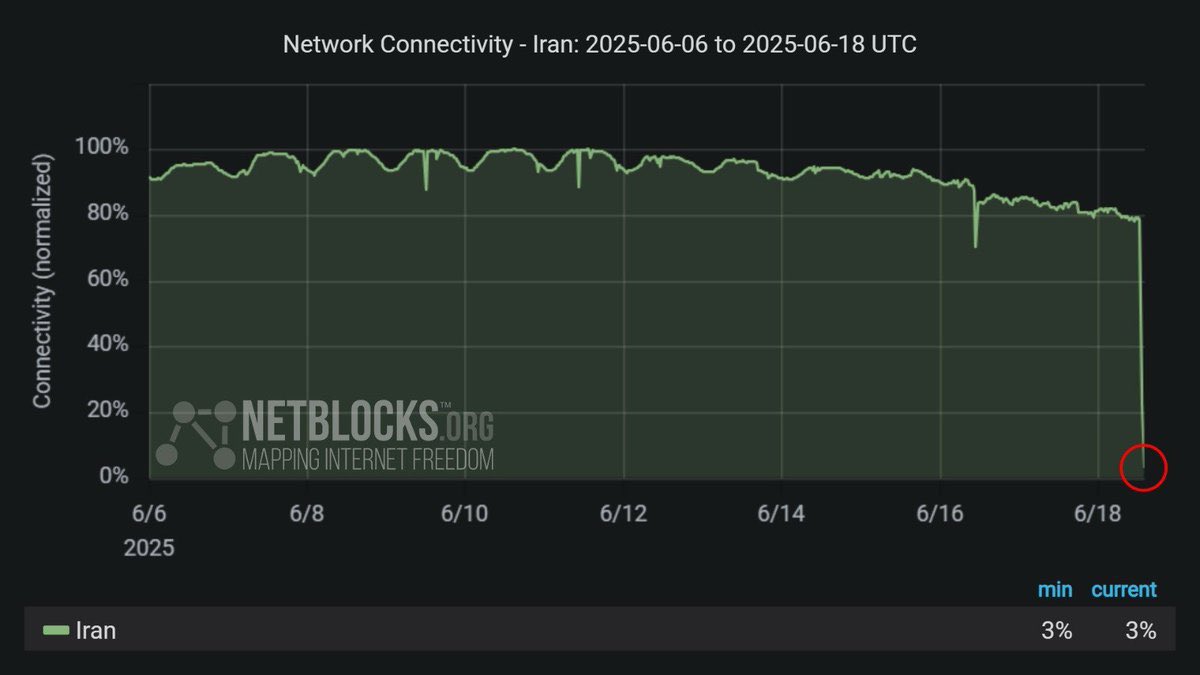Iran is under major internet blackout
Iran is now almost completely offline. Only 3% of the country is still connected to the internet. That’s based on real-time data from NetBlocks, which shows connectivity starting plummeting Monday this week under direct orders from the Iranian regime.
The government triggered the shutdown, cutting off millions from mobile and broadband access. This is the same playbook they used during the 2019 protests, when at least 100 people were killed while the rest of the world was blocked from seeing it.
That blackout lasted six days and kept most of the country in the dark while security forces cracked down. This one comes during military escalation between Israel and Iran, including reports of Israeli airstrikes on Iranian nuclear sites.
Iran blocks communication using national infrastructure and hardware
Research published in the Journal of Cybersecurity in 2024 found that these kinds of shutdowns can slash information flow by 90% within one day. This kind of government blackout only works because Iran owns or controls all major internet infrastructure, via the Telecommunication Company of Iran (TCI), which has the power to throttle or block all traffic.
The country also controls Border Gateway Protocol (BGP), the system that routes traffic in and out of national networks. By pulling BGP route advertisements, Iran can disconnect itself from the global internet, just like Egypt did in 2011 during the Arab Spring, when it cut off 93% of its connectivity for a week, and it’s been studied as a model for censorship ever since.
Iran is not alone in using blackouts to silence people. Countries like India (in Kashmir during 2020) and Myanmar (after the 2021 military coup) have also pulled the plug. Data from Access Now shows that 2024 had a record 67 blackouts worldwide.
Iran targets dissent and shuts out the outside world
Iran is using advanced tech to do it. Deep Packet Inspection (DPI) lets them scan and block apps like Telegram, WhatsApp, and Instagram. These filters are often powered by hardware from companies like Sandvine in Canada and Allot in Israel.
In Iran, DPI is backed by state law and used to block anything not approved by the authorities. There’s also DNS tampering, which lets the regime stop users from reaching foreign sites by rewriting domain addresses, tactics that are part of the government’s plan to build a separate internet.
That separate system already exists. It’s called the National Information Network (NIN). Started in 2012 and expanded since then, NIN acts as a domestic-only intranet, hosting sites like Aparat, the local version of YouTube. NIN allows the state to keep essential services running inside the country while cutting everything else. It’s a key part of this blackout.
The military also plays a major role in all this. The Islamic Revolutionary Guard Corps (IRGC) runs a cybersecurity division that controls surveillance and communications shutdowns. Their team uses Chinese tech from Huawei and some Iranian-made tools to kill signals, especially during high-risk periods. NetBlocks data shows that this week’s blackout came from a mix of BGP withdrawal and mobile network shutdown, likely executed by both TCI and NIN.
There’s no confusion about what this is for. When Iran cut the internet in 2019, it came right after fuel price protests. Amnesty International later confirmed that more than 300 people were killed while the internet was off.
Social media is another reason for the clampdown. Platforms like Twitter and Telegram were critical in organizing demonstrations during the 2009 Green Movement, and the state never forgot that. Those tools are now either banned or instantly blocked when tensions rise.
Another reason? Control over news. Foreign media like BBC Persian and Voice of America are blocked. The state only allows news from official outlets hosted on NIN. The Carnegie Endowment found that blackouts often happen during elections or national crises to control what the public sees.
There’s also a bigger message here. A blackout sends a signal both to citizens and enemies that the government is in charge, though the global economy pays the price. The Internet Society said blackouts caused $2.4 billion in GDP loss worldwide between 2015 and 2016. But Iran, already under sanctions, might not care.
Iran’s rulers think these blackouts help. They believe it stops protests, cuts off hackers, and keeps foreign companies like Google or Amazon from interfering. They want total control.
KEY Difference Wire: the secret tool crypto projects use to get guaranteed media coverage




